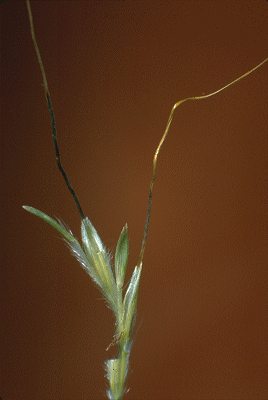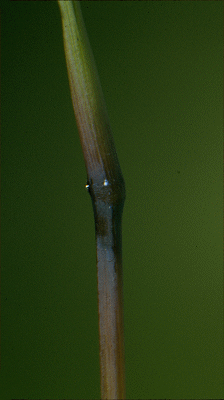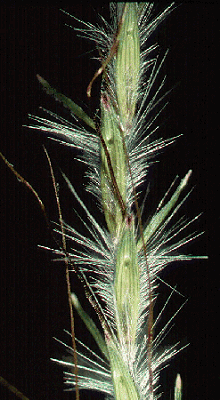Bothriochloa macra (Steud.) S. T. Blake. Proc.
Roy. Soc. Queensland 80: 64 (1969).
Classification. (GPWG 2001) : Subfamily
Panicoideae. Micraireae.
Basionym and/or
Replacement Name: Andropogon
macer Steud., Syn. Pl. Glumac. 1: 371 (1854).
Type of Basionym or
Protologue Information: IT: Urville, Australia: Montagnes bleues
(Montes coerul.) (S-G399). Kew negative 7190.
Recent synonyms:
B. ambigua.
Key references
(books and floras): [2002] D.Sharp & B.K.Simon, AusGrass, Grasses of
Australia, [2006] J.Jessop, G.R.M.Dashorst, F.M.James, Grasses of South
Australia (509), [2008] S.W.L.Jacobs, R.D.B.Walley & D.J.B.Wheeler, Grasses
of New South Wales (169).
Illustrations:
[1983] J.C.Tothill & J.B.Hacker, Grasses of Southern Queensland
(128(8)), [1984] N.T.Burbidge. rev. S.W.L.Jacobs, Australian Grasses (75), [2006] J.Jessop, G.R.M.Dashorst,
F.M.James, Grasses of South Australia (510, fig. 438), [2008] S.W.L.Jacobs,
R.D.B.Whalley & D.J.B.Wheeler, Grasses of New South Wales, 4th edn
(169).
Habit.
Perennial. Culms geniculately ascending, 30–100 cm tall, 2–8 -noded. Mid-culm
nodes glabrous or pubescent. Lateral branches branched. Leaf-sheaths glabrous
on surface. Ligule a fringed membrane, a ciliolate membrane, 1.5–2.5 mm long,
truncate. Leaf-blades flat or revolute, 5–30 cm long, 2.5–5.5 mm wide. Leaf-blade
surface scaberulous, indumented.
Inflorescence.
Inflorescence subdigitate, with ramose branches. Racemes 5–10 cm long. Central
inflorescence axis 0.7–2 cm long. Rhachis fragile at the nodes.
Spikelets.
Spikelets sessile, 1 in the cluster. Companion spikelets pedicelled, 1 in the
cluster. Companion spikelets represented by single glumes or rudimentary,
comprising 2 unequal glumes without lemmas, 4.5–6 mm long. Fertile spikelets
2-flowered, the lower floret barren (rarely male), the upper fertile, comprising
1 basal sterile florets, comprising 1 fertile floret(s), without rachilla
extension, linear or lanceolate, dorsally compressed, 5–7 mm long.
Glumes.
Glumes dissimilar, firmer than fertile lemma. Lower glume elliptic, coriaceous,
without keels, 5–7 -nerved. Lower glume surface glabrous or indumented. Upper
glume lanceolate, keeled, 1-keeled. Florets. Basal sterile florets 1,
barren, without significant palea. Lemma of lower sterile floret 75 % of length
of spikelet, hyaline.
Fertile lemma without
keel. Lemma apex entire, awned, 1 -awned. Median (principal) awn apical, 20–23
mm long overall, with a twisted column. Palea absent. Anthers 3. Grain 3–3.25
mm long.
Continental
Distribution: Australasia.
Australian
Distribution: South Australia, Queensland, New South Wales, Victoria,
Tasmania, Norfolk I.
South Australia:
Flinders Ranges, Eastern, Eyre Peninsula, Northern Lofty, Murray, Southern
Lofty, South-eastern. Queensland: Darling Downs, Moreton, Wide Bay. New
South Wales: North Coast, Central Coast, South Coast, Northern Tablelands,
Central Tablelands, Southern Tablelands, North-Western Slopes, Central-Western
Slopes, South-Western Slopes, North-Western Plains. Victoria: East
Gippsland, Eastern Highlands, Gippsland Plain, Midlands, Murray Mallee, Riverina,
Volcanic Plain, Wannon, Wimmera. Tasmania: East Coast.
Notes.
Exists in both pitted and unpitted states leading to previous problems of
identification, being confused with both Dichanthium sericeum and Bothriochloa
decipiens.
Grows on soils of low
fertility mainly on the tableland area of N.S.W. but extending through Vic. to
Tas. and S.Aus. and to southern Qld; naturalised in New Guinea, Norfolk Is. and
New Zealand. Flowers Oct.--July.






